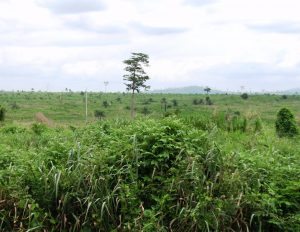The world’s forests seem beset on all sides.
Rising populations and improved incomes are increasing demands for forest products and services ranging from the traditional – food, fuel and timber – to more recently recognized needs such as biomass, bioenergy, nature conservation, recreation and health, as well as forest biodiversity conservation.

“It is a great challenge to restore forest landscape in largely deforested areas.” Photo: John Stanturf.
At the same time, those rising populations – and changing preferences, such as increased demand for meat and dairy products – lead to forests being cleared to free up land for agricultural and pasture purposes.
Add the other drivers of deforestation and forest degradation, plus increasing temperatures, rapidly altering precipitation patterns and the impacts of continuously growing carbon dioxide concentrations on forest vegetation photosynthesis; and then throw in more extreme weather events that lead to more frequent and intensified droughts and wildfires, the migration of tree pests and diseases – aided by globalization – and one has a global forest under siege.
If forests are to survive and prosper in the face of these changing and challenging climatic and societal conditions, more information is needed on the biophysical adaptive capacities of trees and forests, as well as the options for, and limitations of, Adaptive Forest Management (AFM) from stand scale to landscape scale.
That is the reason for IUFRO’s Forest Adaptation and Restoration under Global Change Task Force. The Task Force aims to compile and improve globally available scientific and technical knowledge and experiences on how to achieve optimal adaptation of forests and forest landscapes in the face of global change.
It will achieve this by “identifying knowledge gaps, comparing existing activities and techniques and elaborating best practice approaches,” said Andreas Bolte of the Thünen Institute of Forest Ecosystems, Germany, who is coordinator of the Task Force.
“We will be considering all actions that increase the adaptive capacity of forests and forested landscapes; combining AFM concepts on a stand-scale with Forest Landscape Restoration (FLR) concepts at the landscape level; linking national and trans-national policies, as well as trans-disciplinary expertise in various fields; and integrating experts and working activities among various specialized IUFRO units,” he said.
What has to be done in terms of adaptation and-or restoration can be dependent on where one is located. “Due to often large-scale overexploitation and forest landscape degradation in the tropics and subtropics, forest restoration activities are of particular interest in those regions,” Dr. Bolte said. “On the other hand, assisted migration and stand transformations are important for adapting many forests in the temperate and boreal zones.”
He added that many restored forests would likely be planted forests, both native and exotic to the site, with great potential to support sustainable development of bio-economies, substituting fossil fuels with renewables, providing other ecosystem services and contributing to biodiversity conservation.
Despite all the alarming signals for the forests, the adaptation challenges may also be seen as opportunities. Proper management and expansion of the world’s forests is perhaps the most powerful tool to mitigate climate change. If societies and their decision makers also realize the value of this potential, other ecosystem services may benefit and, in this way, the forest landscape will become better protected too, Dr. Bolte said.
The Task Force on Forest Adaptation and Restoration under Global Change is one of several established by IUFRO to advance knowledge under five research themes in accordance with the IUFRO 2015-19 Strategy.
The five themes are: Forests, Soil and Water Interactions; Forests for People; Forests and Climate Change; Forests and Forest-based Products for a Greener Future; and Biodiversity, Ecosystem Services and Biological Invasions.
Visit the Task Force website: http://www.iufro.org/science/task-forces/forest-adaptation-restoration/
View all IUFRO Spotlights at http://www.iufro.org/media/iufro-spotlights/

Leave a Reply